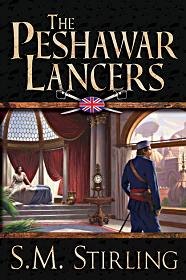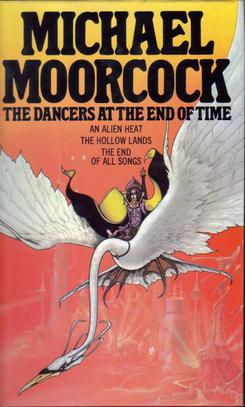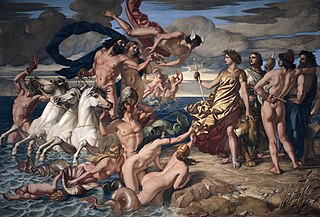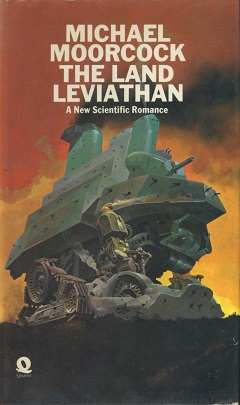
Michael John Moorcock is an English–American writer, particularly of science fiction and fantasy, who has published a number of well-received literary novels as well as comic thrillers, graphic novels and non-fiction. He has worked as an editor and is also a successful musician. He is best known for his novels about the character Elric of Melniboné, which were a seminal influence on the field of fantasy in the 1960s and 1970s.

Steampunk is a subgenre of science fiction that incorporates retrofuturistic technology and aesthetics inspired by, but not limited to, 19th-century industrial steam-powered machinery. Steampunk works are often set in an alternative history of the Victorian era or the American "Wild West", where steam power remains in mainstream use, or in a fantasy world that similarly employs steam power.
Jerry Cornelius is a fictional character created by English author Michael Moorcock. The character is an urban adventurer and an incarnation of the author's Eternal Champion concept. Cornelius is a hipster of ambiguous and occasionally polymorphous gender. Many of the same characters feature in each of several Cornelius books, though the individual books have little connection with one another, having a more metafictional than causal relationship. The first Jerry Cornelius book, The Final Programme, was made into a 1973 film starring Jon Finch and Jenny Runacre. Notting Hill in London features prominently in the stories.
The Eternal Champion is a fictional character created by British author Michael Moorcock and is a recurrent feature in many of his speculative fiction works.
Monsieur Zenith the Albino is an ambiguous villain created by writer Anthony Skene for the "Sexton Blake" series of detective pulp fiction.

The Peshawar Lancers is an alternate history, steampunk, post-apocalyptic fiction adventure novel by S. M. Stirling, with its point of divergence occurring in 1878 when the Earth is struck by a devastating meteor shower. The novel's plot takes place in 2025, when the British Empire has become the powerful Angrezi Raj and is gradually recolonizing the world, alongside other nations and empires that were able to survive. The novel was published in 2002, and was a Sidewise Award nominee for best long-form alternate history.

The Dancers at the End of Time is a series of science fiction novels and short stories written by Michael Moorcock, the setting of which is the End of Time, an era "where entropy is king and the universe has begun collapsing upon itself". The inhabitants of this era are immortal decadents, who create flights of fancy via the use of power rings that draw on energy devised and stored by their ancestors millions of years prior. Time travel is possible, and throughout the series various points in time are visited and revisited. Space travellers are also common, but most residents of the End of Time find leaving the planet distasteful and clichéd. The title of the series is itself taken from a poem by a fictitious 19th-century poet, Ernest Wheldrake, which Mrs. Amelia Underwood quotes in The End of All Songs. "Ernest Wheldrake" had been a pseudonym used by Algernon Charles Swinburne.

Robur the Conqueror is a science fiction novel by Jules Verne, published in 1886. It is also known as The Clipper of the Clouds. It has a sequel, Master of the World, which was published in 1904.

Master of the World, published in 1904, is one of the last novels by French pioneer science fiction writer, Jules Verne. At the time Verne wrote the novel, his health was failing. Master of the World is a "black novel," filled with foreboding and fear of the rise of tyrants such as the novel's villain, Robur, and totalitarianism. Master of the World contains a number of scientific ideas, current to Verne's time, which are now widely known to be errors. For example, traveling at high speed does not reduce a vehicle's weight.

The Eternal Champion is a fantasy novel by Michael Moorcock that introduces the hero known as both John Daker and Erekosë. Originally written in the late 1950s, it constitutes the first novel of Moorcock's sprawling Eternal Champion series. The tale was first published in 1962 as a magazine novella Moorcock expanded the novella to novel length for publication in 1970. He revised the text for its 1978 publication. Along with expanding the original story, the novel makes some minor changes to narration and scenes, and also includes references to other short stories by Moorcock. The Eternal Champion is the first in a trilogy of novels known as the Erekosë series. The sequel novels are Phoenix in Obsidian, and The Dragon in the Sword (1987).

The City in the Autumn Stars: Being a Continuation of the Story of the Von Bek Family and Its Association With Lucifer, Prince of Darkness is a science fantasy novel by British author Michael Moorcock. The second book in the Von Bek trilogy, it was published by Grafton in 1986. The story centres on the characters of Manfred von Bek, a descendant of Ulrich von Bek, who is also the protagonist of the previous book in the series and Libussa Cartagena y Mendoza-Chilperic, the Duchess of Crete, along with their journey to the mystical Mittelmarch, and their search for the Holy Grail.

The British Empire has often been portrayed in fiction. Originally such works described the Empire because it was a contemporary part of life; nowadays fictional references are also frequently made in a steampunk context.
Oswald Bastable is a fictional character created by Michael Moorcock. He is the protagonist in The Warlord of the Air, The Land Leviathan, and The Steel Tsar, and appears in other stories.

The Story of the Treasure Seekers is a novel by E. Nesbit first published in 1899. It tells the story of Dora, Oswald, Dicky, Alice, Noel, and Horace Octavius Bastable, and their attempts to assist their widowed father and recover the fortunes of their family. The novel's complete name is The Story of the Treasure Seekers: Being the Adventures of the Bastable Children in Search of a Fortune. The original edition included illustrations by H. R. Millar. The Puffin edition (1958) was illustrated by Cecil Leslie. Its sequels are The Wouldbegoods (1901) and The New Treasure Seekers (1904).

The Land Leviathan: A New Scientific Romance is an alternative history novel by Michael Moorcock, first published in 1974. Subtitled "A New Scientific Romance", it has been seen as an early steampunk novel, dealing with an alternative British Imperial history dominated by airships and futuristic warfare. It is a sequel to The Warlord of the Air (1971) and followed by The Steel Tsar (1981). This proto-steampunk trilogy is also published as the compilation volume A Nomad of the Time Streams.

The Steel Tsar is a sci-fi/alternate history novel by Michael Moorcock, first published in 1981 by Granada. Being a sequel to The Warlord of the Air (1971) and The Land Leviathan (1974), it is the final part of Moorcock's A Nomad of the Time Streams trilogy regarding the adventures of Captain Oswald Bastable and which has been seen as an early example of steampunk fiction. The same cover image was used for the 1984 reissue of Judas Priest album Rocka Rolla and also the 1989 video game Ballistix.

A Nomad of the Time Streams is a compilation volume of Michael Moorcock's early steampunk trilogy, begun in 1971 with The Warlord of the Air and continued by its 1974 and 1981 sequels, The Land Leviathan and The Steel Tsar. The trilogy follows the adventures of Edwardian-era British Army Captain Oswald Bastable in alternate versions of the 20th century.
Una Persson is a recurring character in many of Michael Moorcock's 'multiverse' novels. She has also been used as a character in stories by other writers. She was the character Moorcock chose to start a round-robin story in The Guardian.

Planesrunner is a 2011 young adult science fiction novel by British author Ian McDonald, and the first installment of the Everness series. The book follows British teenager Everett Singh as he travels between alternate universes in search of his missing theoretical physicist father.














